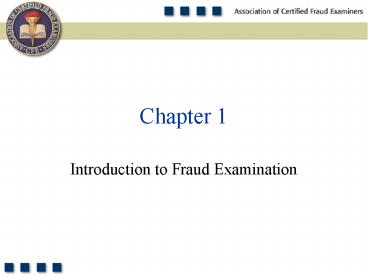Introduction to Fraud Examination - PowerPoint PPT Presentation
Title:
Introduction to Fraud Examination
Description:
Give examples of non-shareable problems that contribute to fraud. ... the deliberate misuse or misapplication of the employing organization's resources or assets ... – PowerPoint PPT presentation
Number of Views:512
Avg rating:3.0/5.0
Title: Introduction to Fraud Examination
1
Chapter 1
- Introduction to Fraud Examination
2
Learning Objectives
- Understand the fraud theory approach.
- Define occupational fraud.
- Define fraud.
- Define abuse.
- Know the difference between fraud and abuse.
- Describe the criminological contributions of
Edwin H. Sutherland. - Understand Donald Cresseys hypothesis.
- Give examples of non-shareable problems that
contribute to fraud. - Understand how perceived opportunity and
rationalization contribute to fraud. - Explain W. Steve Albrechts fraud scale.
- Summarize the conclusions of the HollingerClark
study. - Summarize the results of the 2004 National Fraud
Survey.
3
Discipline of Fraud Examination
- Resolving allegations of fraud from tips,
complaints or accounting clues - Documentary evidence
- Interviewing witnesses
- Writing investigative reports
- Testifying
- Assisting in the detection and prevention of
fraud - Forensic accounting vs. fraud examination
4
Auditing vs. Fraud Examination
- Issue Auditing Fraud Examination
- Timing Recurring Nonrecurring
Scope General Specific
Objective Opinion Affix blame
Relationship Nonadversarial Adversarial
Methodology Audit techniques Fraud
examination techniques
Presumption Professional Proof skepticism
5
Fraud Examination Methodology
- Predication
- Totality of circumstances that would lead a
reasonable, professionally trained, and prudent
individual to believe a fraud has occurred, is
occurring, and/or will occur - Fraud examinations must be based on predication
6
Fraud Theory Approach
- Analyze available data
- Create a hypothesis
- Test the hypothesis
- Refine and amend the hypothesis
7
Tools Used in Fraud Examination
Observation
8
Defining Occupational Fraud and Abuse
- The use of ones occupation for personal
enrichment through the deliberate misuse or
misapplication of the employing organizations
resources or assets
9
Elements of Fraud
- A material false statement
- Knowledge that the statement was false when it
was uttered - Reliance on the false statement by the victim
- Damages resulting from the victims reliance on
the false statement
10
Occupational Fraud and Abuse Research
- Edward Sutherland
- Donald Cressey
- Cresseys Hypothesis
11
Fraud Triangle
Opportunity
Pressure
Rationalization
12
2004 Report to the Nation on Occupational Fraud
Abuse
- Nationwide surveys
- Measuring the costs of occupational fraud
- 6 percent lost to fraud
- 600 billion annually in the U.S.
- Perpetrators of fraud
13
Position of Perpetrator
14
Median Loss by Position
15
Median Loss by Gender
16
Median Loss per Number of Employees
17
Initial Detection of Frauds
18
Occupational Fraud and Abuse
Asset Misappropriations
Corruption
Fraudulent Statements
Conflicts of Interest
Cash
Financial
Bribery
Inventory All Other Assets
Nonfinancial
Illegal Gratuities
Economic Extortion































